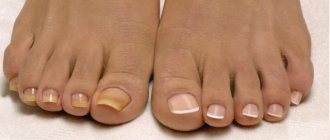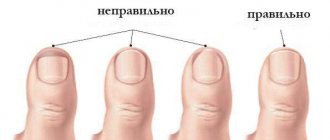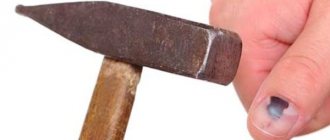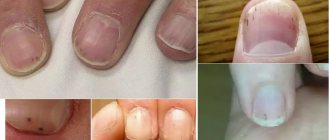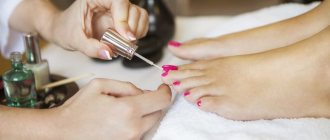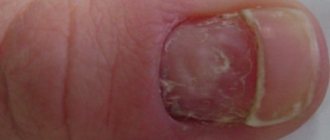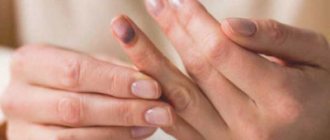Causes of blackened nails
Changes in nail color can be due to various reasons:
- traumatic hemorrhage,
- fungal infections,
- liver diseases,
- heart and respiratory failure,
- oncological tumors.
If the blackening of the nail is caused by damage to the finger, the victim must be given emergency assistance using the method of treating bruises .
In other cases with an unclear etiology, you need to immediately visit a doctor.
| Self-medication of a black nail with ointments, poultices, decoctions on the advice of a friend (neighbor) is unacceptable, this can cause irreversible consequences: sepsis, gangrene, atrophy of muscles and internal organs of the body. |
Causes of blackening of the nail on the big finger and toes
The big toe and hand are often injured. When injured, pain in the fingers may last for several weeks. Painful sensations indicate cell death. The cause of darkening of the thumbnail is microsis. This is a viral disease that anyone can become infected with. The risk of infection occurs in public places, such as a sauna, bathhouse, shared shower or locker room. It is impossible to cure microsis on your own. Other reasons include:
- Green and black spots on the nail indicate a disruption of the gastrointestinal tract.
- Black nails with blue spots indicate poor circulation.
- Black and burgundy spots appear when there are problems with the central nervous system of the brain.
- Hemangioma leads to the growth of darkened vessels under the nail. In addition to darkening, it causes severe pain. If you have such symptoms, you should go to the doctor. In addition to drug treatment, it is important to follow the rules of a healthy diet and take baths.
Why do nails darken?
The main cause of blackening of the nail is hemorrhage due to injury:
- bruise,
- pinching,
- constant compression of tissues when wearing narrow shoes.
If the hematoma is minor, you can treat the nail at home. As the nail grows, the blackness spontaneously disappears.
| If there is a large accumulation of blood, detachment of the nail plate, damage to the skin, or acute pain, you should immediately contact the emergency room to exclude a fracture of the finger and proper antibacterial treatment. |
Other dangerous causes of partial (dots, spots, stripes) or complete blackening , bluing of nails:
- bacterial infections,
- fungal diseases,
- frostbite,
- avitaminosis,
- obstructive changes in the lungs,
- liver diseases,
- renal failure,
- oncology (melanoma),
- hemangioma (benign tumor),
- diabetes,
- gastrointestinal diseases,
- intoxication with heavy metals and drugs.
Household external factors that are not hazardous to health for changing the color of nails are stains from tobacco, varnish, and all kinds of dyes used at work and at home.
If the color of nails suddenly changes to black, blue, or brown in the absence of a traumatic factor, it is important to promptly determine the exact cause, since pigmentation may indicate extensive internal damage to the body.
Why do fingernails turn black?
Typically, girls immediately notice defects on their hands, which consist of darkening of the nails or the formation of dark spots. Such damage to the plate should not be neglected to prevent complications from occurring.
There are many reasons for the darkening of the surface; they are divided into two types: internal and external. The former imply the presence of problems in the body, organ dysfunction, the latter are more harmless, since they involve the influence of external factors that can be independently eliminated and diagnosed.
Due to the fact that the tips of the fingers are interconnected with the entire body, the visual state of the manicure and its damage can serve as an “alarm signal” for a girl, which indicates the presence of inflammatory processes.
There are several external factors:
- Mechanical damage. Injury, bruising or pinching of the fingers or palms themselves often leads to the formation of bruises that appear under the nail plate, as well as on its surface. Darkening is accompanied by pain.
- Contact with chemicals. When working with aggressive products without using gloves, they can penetrate the structure of the stratum corneum and damage them, which will affect the health of the manicure.
- Illiterate manicure. Even when treating the nail bed in a salon, careless trimming of the free edge and cuticle can affect the location of the stratum corneum, which ultimately leads to damage to the nail.
- Frostbite. A problem often arises when the area becomes overcooled when girls neglect to wear warm gloves or mittens. Then blood circulation slows down, making it difficult to restore the condition of the nails.
Blueness of the nail on the hands due to a mechanical injury to the finger is associated with hemorrhage in this area, impaired blood circulation and the integrity of blood vessels, which leads to the formation of a bruise or hematoma.
It is not difficult to correct and prevent external factors, since they usually go away spontaneously without additional treatment, and then a healthy nail grows back.
There are more internal causes of blackening:
- Fungal infection.
- Kidney and liver diseases.
- The presence of a benign or malignant tumor.
- Diabetes.
- Circulatory disorders.
- Dysfunction of the cardiovascular system.
- Pigmentation disorder, which is associated with a surge of melanin in epithelial cells.
To diagnose internal damage to the body, you need to see a doctor and undergo the prescribed tests. Only based on their results is it possible to make a diagnosis and prescribe a treatment regimen for blackness.
Keep in mind that sometimes darkening of the nail bed occurs after an infectious disease, which was accompanied by inflammatory processes, so the defect gradually disappears after treatment.
The only thing is that the girl herself can recognize a fungal infection as the causative agent of the symptoms, since it is usually accompanied by a number of other signs: thickening of the coating, the formation of irregularities, roughness, the appearance of white and dark spots.
How to treat bruised nails
What happens during an injury:
- hemorrhage occurs in the soft tissues, which puts strong pressure on the area of the nail plate.
- The person experiences severe bursting pain.
- The hematoma from the accumulation of blood begins to increase, lifting and tearing the nail away from the skin of the bed.
- There is an urgent need to stop the development of extensive bleeding and relieve the person of pain.
- Prevent finger infection.
External factors
The most common cause of darkening of one toenail is a hematoma or bruise localized under the nail plate, which is visible through its surface. In this case, the plate itself does not change color.
Injury can occur not only from a blow, but also from prolonged squeezing of the toes by uncomfortable shoes, in which the impact is not very strong, but constant. The thumb and little finger are usually hit.
Another possibility for injury is an unsuccessful pedicure or manicure on your hands. As a result, the vessel may rupture and blood accumulates on the nail bed.
If your big toenails have darkened for this reason, the spot usually gradually changes color, shape and location, like a regular bruise under the skin. Such hematomas can bring not only pain and inconvenience, but if the outcome is unfavorable, they can cause inflammation and loss of the nail.
Other external factors for color change include:
- Coloring of plates from the use of decorative varnish, socks, tights, shoes with strong low-quality dye. People with excessive sweating of the feet suffer especially often due to this reason.
- The appearance of nails can be ruined by contact with chemicals or medications. Iodine, brilliant green or potassium permanganate have a sharp color and the ability to be quickly absorbed and remain on the surface for a long time. The plates have pores into which the colored substance penetrates.
- Frostbite on the feet can lead to darkening of the nail plates.
- The most common and unpleasant cause of darkened nails is a fungal infection. This factor can be classified as internal, since infection and development of onychomycosis is associated with loss of immunity and general weakening of the body, and not just penetration of the pathogen.
Onychomycosis is caused by several types of fungi. They lead to dark spots, thickening or thinning of the plates, and deformation. When the form is neglected, the toenails begin to peel, disintegrate, and fall off the bed.
Important: starting on the skin and toenails, a fungal infection can spread to internal organs and become generalized.
In what situations is urgent medical attention needed?
If a child’s nail turns black, it is imperative to see a doctor , regardless of the extent of the damage.
An adult should call an ambulance under the following circumstances of a blackened nail from a bruise:
- continuous bleeding
- deep wound,
- fracture of the finger bone,
- severe pain,
- tearing of the nail plate,
- contamination of the wound with soil,
- the finger dangles or does not bend.
! It is imperative to get a tetanus vaccination if more than 5 years have passed since vaccination. Do not delay a visit to the doctor even if the nail is slightly blackened in cases of formation of an inflammatory process: redness of the skin of the nail folds, the appearance of purulent discharge, increased swelling of the finger.
External reasons for the appearance
There are certain reasons that lead to blackening of the nail. External reasons include:
- External painting . Doesn't happen very often. This coloring occurs after the nail plate comes into contact with certain substances. For example, after contact with potassium permanganate, it can seriously turn black or blue. Sometimes external staining occurs after using cheap, low-quality varnishes that were applied without special treatment. The basis of such varnishes is made up of aggressive components, which are difficult to get rid of even with the help of nail polish remover. In especially difficult cases, you can get rid of this problem only by completely growing the nail.
- Damage . If a blackened nail appears from a blow or bruise, then do not worry too much. The color changes due to a slight hemorrhage following the injury. This does not pose any harm to health. In some cases, the color changes not even due to bruises or minor injuries, but due to wearing shoes that are too tight. It can lead to damage to blood vessels, which leads to discoloration of the nail.
It is quite easy to determine that the nail has been damaged as a result of injury. In this case, there is a local change in color and blurring of the edges of the nail. Initially, the nail acquires a bluish color and only over time begins to turn black.
During mechanical damage, the nail begins to move away from the bed and gradually peel off altogether.
Medicines for the treatment of black nails after injury
The healing process of soft tissues and nail plates damaged by bruises or pinching is delayed for a long time: the growth of a new healthy nail occurs in six months, or even a year. Throughout this period, it is necessary to protect the wound surface of the epithelium from the penetration of various types of infectious agents :
- pathogenic bacteria,
- viruses,
- fungi,
- protozoa.
Internal reasons
There are many internal reasons. These include:
- Fungus . A blackened thumbnail may be caused by a fungus. In medicine, this disease is called medanonychia. Most often it occurs in people with weak immune systems. The disease also occurs in adolescents, children and pregnant women. In this case, the nail does not darken immediately, but gradually. The color change starts from the base of the nail. It is very easy to determine that the cause of blackening is a fungus. To do this, you need to pay attention to its growth. If the base of the plate is dark even during growth, then you can be sure that it is a fungus.
- Benign tumor . The color of the nail changes due to the proliferation of blood vessels. Only a doctor can get rid of this problem.
- Systemic diseases . These include diabetes, kidney problems and cardiovascular diseases. Only proper treatment will help solve the problem.
Read: How to prepare a foot bath for foot fungus
Anesthesia
The doctor will determine which medications are necessary for an individual patient; here is a list of the most popular medications for the treatment of black nails:
- Compresses to reduce pain are made using an aqueous solution of Dimexide (2 times a day for 30 minutes), Novocain.
- They use anti-inflammatory painkillers: Analgin, Ibuprofen, Nise, Ketanov.
- Diclofenac, Ibuprofen, and Troxevasin ointments have anesthetic properties.
Anti-inflammatory and regenerating agents
- Relieve swelling and promote resorption of hematomas: Heparin ointment, Riciniol, Troxevasin. Herbal ointments Bodyaga Forte, Comfrey, Calendula.
- Cooling ointments with Menthol and Arnica are used to prevent the formation of hematoma and swelling immediately after a bruise.
- To activate tissue restoration, spray (or gel) Panthenol, Bepanten, Solcoseryl are used.
- When tissue inflammation occurs, doctors recommend lubricating the finger with Levomekol ointment and Ketonal cream.
Medical assistance
If home treatments do not help and it is not clear what to do if the nail turns black and hurts, then it is better to consult a doctor.
Most often, a doctor’s help is needed if the blackening of the nail was caused by a fungus. To treat it, you should visit a dermatologist or mycologist. During the examination, the specialist will assess the structure of the nail and its thickness. The doctor should also take tissue scrapings to conduct further tests. This will help prescribe effective treatment. During the examination, the shape of the lesion and the extent of the process are determined.
For treatment, local and general agents are used. Local treatment is used if the disease was detected at the initial stage. In this case, antifungal drugs are used. These include creams, ointments or solutions.
Sometimes doctors perform special procedures before applying the cream. They are intended for preparing nails. A soap and soda bath is made. To do this, fill a basin with warm water and dissolve 50 g of laundry soap and one tablespoon of soda in it. Damaged fingers are placed in the solution for 20 minutes. If this treatment does not help, a course of antibiotics is prescribed.
What to do when a black nail plate peels off
If it is not possible to visit the surgeon’s office, the following safety measures should be taken:
- carefully trim off the plates extending from the nail bed,
- protect the wound with a bandage,
- disinfect the surface of injured tissues two to three times a day,
- lubricate with anti-inflammatory ointments.
Gradually the nail will come off spontaneously.
Forced removal will be required if the finger becomes infected and an inflammatory process begins.
What to do if your toenails turn black
There are many ways to get rid of this problem. They depend on the reasons for its appearance. Therefore, you first need to find out why your nails turned black. You can get rid of blackening caused by injury without medical help. The treatment is almost no different from the treatment of a regular hematoma:
- After an injury, the finger should be quickly placed in ice or cold water. To speed up the recovery process, the procedure must be repeated several times a day.
- Be sure to disinfect your finger. This will stop the infection from developing and prevent bacteria from entering.
- With a serious injury, the finger may not just turn black, but also a large hematoma. In this case, it will not be possible to solve the problem without opening it. It is not recommended to do this yourself, as it may become infected.
If blackened fingernails are caused by a fungus, you won’t be able to get rid of it on your own. You should visit a doctor immediately. The only thing that can be done in this case is to prevent the fungus from spreading further. To do this, you must adhere to the following rules:
- treat your nails with iodine several times a day;
- for healthy and damaged nails you should use different manicure tools;
- you need to ensure that the skin on your feet remains dry;
- change socks as often as possible;
- In the solarium, swimming pool or sauna, you should wear closed rubber slippers.
Principles of first aid
If you receive an injury in the form of a blow or pinching, there are generally accepted algorithms for providing first aid. If the finger is not fractured and the nail is not peeled off, but has turned black, then you can begin to provide assistance at home.
It has long been known that applying cold is necessary to relieve pain and reduce swelling after an impact. This is especially necessary if the nail immediately turns black. It is worth remembering that in field conditions the finger must be protected from sudden movements, since the possibility of a fracture cannot be ruled out. Moreover, an injured nail, despite its small size, causes severe, intense pain.
If it is possible and there is no open bleeding, then it is necessary to apply cold water to the finger.
This will narrow the blood vessels and stop internal bleeding. It is useful to do this so that the nail does not turn black. Water can be replaced with a cold object or ice. Keeping ice for more than 10-15 minutes is not recommended, as there is still a risk of frostbite, which is even more dangerous than bruising. When intense pain is present and the nail is very black, you can apply the cold again after a ten-minute break.
In situations where there is an open wound, bleeding or abrasion, it is necessary to carry out antiseptic treatment. The finger can be lubricated with iodine, hydrogen peroxide, and then apply a sterile or clean bandage. If the nail begins to peel off after a blow and becomes very black, then it needs to be fixed as soon as possible.
The procedure for complete removal of the nail plate is carried out in a sterile hospital environment. It is not recommended to fix the nail plate with an adhesive plaster, since its subsequent removal can cause traumatic effects and tearing of the plate.
There are several options for treating a damaged nail after a blow and other injuries, but only a doctor can determine the exact algorithm.
Symptoms of pain and blackening may indicate a fracture or dislocation. You may take painkillers before arriving at the hospital. Drugs from the group of non-steroidal anti-inflammatory drugs (Nimesulide, Ketorol, Ibuprofen) and analgesics (Analgin, Citramon) are effective for pain relief.
